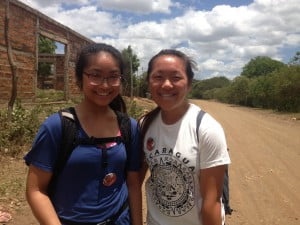
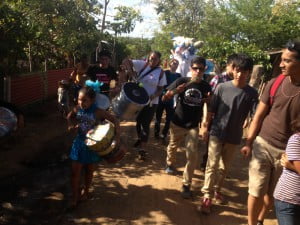
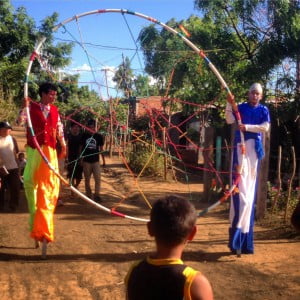
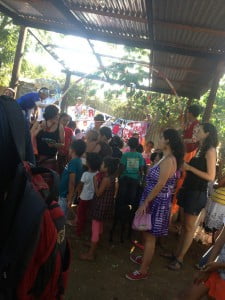
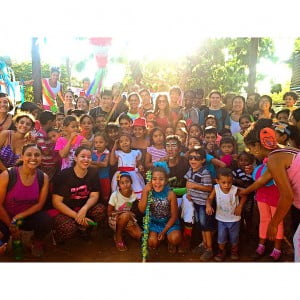
ELDD 1: Maggie Luo
Yesterday’s nightly meeting marked the start of the Living on $1 a Day challenge! Instead of using the electricity in the hostal, such as the lights and fans, we resorted to our pocket flashlights and candles to be able to see in the dark. We also couldn’t use the showerheads, and a few of us tried taking a bucket shower instead. All of these small routines that we take for granted helped us to see what it is like to live differently. Half of us relaxed at the hostal while the other half watched a play about gender violence in town. At first, some of us were nervous for the night we had ahead of us, but we all took the challenge very well and managed to sleep well and feel ready for the next day.
We started off our day by waking up at 8:00 AM and getting ready for our first and most important meal of the day at “Quiero Mas.” Each person had their serving of gallo pinto and drank water instead of our usual iced tea or fresh juice. After breakfast, we walked back to the hostal and had our Community Action Project (CAP) seminar, where we each of us wrote down our ideas for CAP after visiting Los Pocitos on Thursday. We discussed what ideas we wanted to focus on, and asked ourselves if our ideas were feasible, sustainable, needed, and impactful. An important question in general for us to consider was also how a community helps improve difficult circumstances. Eventually, we committed to planting a garden, painting a mural to motivate students, and building a canopy to provide shade for the playground because the heat from the sun can be overwhelming for the children.
Next, we prepared for our private bus ride to a small community called Tomas Borge about 20 minutes away from Leon. Each of us were placed in a home either individually or with a partner, and we ate to-go lunches from “Quiero Mas” with our families. All of us had a ton of fun within the homes we were assigned to! Some of us got to experience of pumping water from a community well and others admired the cute chickens walking around the yard. I was partners with Harnoor and Ivy, and we were able to play dominoes, a marble game, and Frisbee with the children in the home we stayed at. We ended up getting our hands and feet incredibly dusty from the strong winds and loose dirt, but it was worth it because we had a lot of fun!
However, while staying there, I couldn’t help but realize how different my lifestyle back home in California was from the lifestyle in Tomas Borge. Running water is as accessible as a quick five steps to the bathroom in my home, whereas families in the community have to walk to a well and physically pump the water out into buckets they then have to carry back to their homes. And yet, the mother I was staying with was happy to carry two full buckets of water on her own, and the children were happy with playing dominoes or marbles on the dirt floors in their homes for hours! Thinking back to my life at home, I felt ridiculous for complaining about not having good Wi-Fi connection in my living room, or that I didn’t have enough conditioner for my hair, or like Ricky said, “Getting angry at my Kit-Kat ripping in half.” I now understand that when there are so many other problems that these families have to think about, it’s hard to care about the dirt, flies, and buckets of water.
Finally, the community held a parade for the children by playing drums and dancing around the neighborhood while stopping every now and then to play a game. At the end of the parade, the kids wrote their dreams on a piece of paper and attached it to a giant community dream-catcher for the finale. Some of the dreams included having a preschool, health clinic and environmental projects for children in the community. Once we thanked the community leaders, we took the bus back to the hostel and went to dinner at “Quiero Mas” to have our final Living on $1 a Day meal. We finished off the day with a nightly meeting and went to bed early for the next day.
Although the Living on $1 a Day challenge was tough for some of us, we managed to handle it very well and learn a lot from the experience. We only had to go through the challenge for a few hours, but there are about 1.5 billion people in the world who live on less than a dollar every single day. Personally, it made me stop and think more about how I live my life, and I will carry my experience at Tomas Borge with me forever.
ELDD 2: Marianne Rara
Hi friends and family! Although today was the half way point of our journey, the beginning of this amazing journey’s end, our day was still filled with positive vibes and extraordinary energy! To preface our experience of living on a dollar a day, we were asked “how can a community help improve difficult circumstances?”
The Living on $1 a Day Challenge was designed to allow students to experience the living conditions and lifestyles of a third of the world. To fully encompass what it means to live on a dollar a day, our program coordinators challenged us to not use electricity and running showers; this meant showering with buckets of water and no electrical fan usage throughout the duration of the challenge. The challenge started right after our nightly meeting, when half of the group went to watch a play about gender violence and the other half sat in the dark and chilled with one another.
Although our group was anxious about the day ahead of us, it was filled with surprises; the next morning we all took bucket showers and found that pouring a pan of cold water over our bodies was the best kind of wake up call. We had a typical breakfast of gallo pinto at “Quiero Mas” and then all returned to the hostel and had our CAP Seminar. During the seminar, our group brainstormed ideas for projects that we could focus on to leave a sustainable impact on our project community, Monte Redondo. We decided that we’d work on three main projects for CAP: 1) planting trees and a sustainable garden at the preschool, 2) painting murals on the school walls, and 3) building a temporary cover for the preschoolers’ play structure. While our three main projects are going on, the delegation decided to conduct side projects such as buying new supplies for the preschoolers, creating a newer and cleaner trash system, varnishing the kids’ dining area, and finding educational songs that can be used to repeatedly teach lessons.
After our CAP Seminar, our delegation took a private bus to the $1 a Day community named Tomas Borges. The group walked through Tomas Borge’s dirt road streets and dropped off students in their respective homes for the day. The students engaged in different activities with their host families: some of the Glimpsers played with the children, others helped pump water from a local well and carry the buckets back to the family’s home, some shared stories with their families, and others helped clean beans and make tortillas from scratch! The five hours that were designated for our stay in Tomas Borge seemed like an extremely large amount of time; however, all of the students had a fabulous time and were surprised by how quickly the experience went by. The community invited us to be a part of their cultural event, and towards the end of our stay a circus group and the dance group that taught us how to walk on stilts at the beginning of the trip—Fuego y Son—held a parade and performed throughout Tomas Borge’s streets! The performers painted community members’ faces, gave colorful balloons to the children, walked around dressed in costumes on stilts, and played fast, upbeat rhythms on their drums. At the end of the cultural event, community members held a ceremony; they wrote what they envisioned their community being in 5 years on colorful pieces of paper shaped like leaves, and after sharing their dreams with the rest of the community, placed them in a ginormous, community-made dream catcher!
When we left Tomas Borges, we travelled to our hostel to clean up a little bit before having another simple meal of gallo pinto at “Quiero Mas.” After dinner, we came back to the hostel to have our nightly meeting and reflection time. We revisited the question of the day: how can a community help improve difficult circumstances? One of the most valuable lessons that we took back from our time at Tomas Borges was that despite the hard living conditions of the people and the fact that they don’t have much to live on and offer, they all still found joy in the simplest of things. The people of the community came together and celebrated their culture and identity by throwing an energetic, colorful, and fun event filled with smiles and laughter. All of the students forged lasting ties with the people of the community. I think Brayan encompassed how everyone felt when we had to leave: when it was time to go, a little boy named Ariel was clinging to Brayan and asked him a question, and after Brayan responded Ariel frowned. As we were all walking back to our private bus Brayan said, “That was the hardest question I’ve ever had to answer… ‘Are you coming back tomorrow?”

Hi Marianne!
Thank you for taking us to Tomas Borges and also for sharing your experience with the locals there.. I couldn’t help but to reminisce my life as a little girl growing up in the Philippines. I am truly thankful that you have the chance to visit Nicaragua. It is God’s will that you and the other glimpsers were given the opportunity to personally encounter how to live simply which we seldom see here in America.
Papa, Ate and myself miss you so much. Our house is very quiet when you are not around
Looking forward to next week at SFO. In the meantime, you all have fun and be safe!
Mama
Hi Magie,Jessica,Eric and all other students,
Thank you all for your writing in the blog and post photos. We’re very happy to see you all have a great time and incredible experience. As a parents, We’re proud of you and love you all.